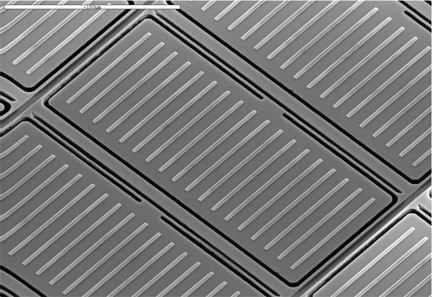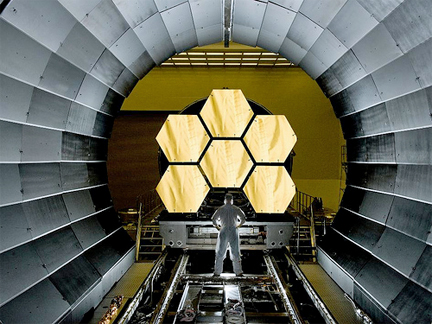
[SatNews] NASA's James Webb Space Telescope microshutters have taken a short jaunt in preparation of its million mile journey in four years.

Closeup of the microshutters on NIRSpec.
Image courtesy of NASA.
The microshutters were moved into a NASA Goddard cleanroom for testing to verify they work correctly before being installed in the Webb's Near Infrared Spectrograph (NIRSpec) instrument. NIRSpec is a powerful instrument that will record the spectra of light from distant objects. The microshutters, a key component of NIRSpec, are a new technology specifically developed for the Webb telescope. They only let light in from selected objects to reach NIRSpec's detectors.
"What is special about the microshutter device is it can select many objects in one viewing for simultaneous observation and it is programmable for any field of objects in the sky," said Paul Geithner, deputy project manager-technical for the Webb telescope at NASA's Goddard Space Flight Center in Greenbelt, Maryland.
"Other spectroscopic instruments have flown in space before but none have had this programmable multi-object capability that enables observation of up to 100 objects simultaneously, which means much more scientific investigating can get done in less time. Moreover, because NIRSpec's operating temperature is extremely cold or "cryogenic," the microshutter device posed a particularly difficult engineering challenge."

Primary Mirror Segment Cryogenic Testing.
Photo courtesy of NASA.
Microshutters are basically tiny windows with shutters that each measure 100 by 200 microns, or about the size of a bundle of only a few human hairs. They were conceptualized and created at NASA Goddard. The entire microshutter device consists of more than 62,000 individual windows with shutters arrayed in a waffle-like grid. One of four array quadrants of the microshutter device is about the size of a postage stamp. Four of these arrays are butted together two-by-two into one microshutter device. Prior to an observation, each individual microshutter is opened or closed when a magnetic arm sweeps past, depending on whether or not it receives an electrical signal that tells it to be opened or closed. An open shutter lets light from a selected target in a particular part of the sky to pass through to NIRSpec's detectors while a closed shutter blocks unwanted light from any objects that scientists don't want to observe. It is this programmable controllability that allows the instrument to do spectroscopy on so many different selected objects simultaneously from one viewing to the next.
After the clean room testing, the next journey for the microshutters is their installation into the NIRSpec. Then the NIRSpec, complete with its microshutters, will be tested in a vacuum at extremely cold temperatures of a thermal vacuum to simulate the environment it will experience in space to ensure everything works after Webb is launched.
For more information about the James Webb Space Telescope, please visit http://www.nasa.gov/webb.

